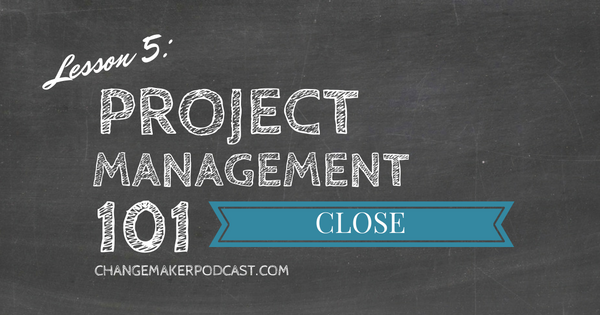Get more good stuff.

This is it! The final step involved with managing a project – closing it out. We’ll discuss the steps for a smooth implementation and transition, documenting lessons learned, and celebrating!
The 5 key steps to managing a project are:
- Idea Approval – What do you want to do? Why?
- Plan – How are you going to do it?
- Execute – Let’s get it done!
- Check and Control – Keep the project on track.
- Close – Wrap up the project.
Close – Wrap Up the Project
We’ve completed all of the work during the Execute phase and verified that our deliverables match the requirements and scope during the Check and Control phase.
Now we’re at the last stage in the project management process – ready to deliver and close out our project. Closing a project involves the following steps:
- Implementation Plan
- Go / No-Go Meeting
- Lessons Learned
- Celebration
Implementation Plan
The implementation plan documents the steps needed to deliver the project results and transition ongoing operations. Since more is known about the project as time goes on, the implementation plan is created closer to the actual implementation, rather than at the start of the project.
We’ll continue to use the adventure travel website example. The implementation plan should include the following:
Steps to Deliver Results
- List the steps involved with delivering the final product, service, or result of the project. Include a post-implementation test to verify that each step was followed appropriately.
Example:
- Migrate the website to the live domain – adventuretravelfun [dot] com
- Link the shopping cart to the real bank account.
- Have the “book now” button send an email to the main office instead of test mailbox.
- Post Verification Test – Ensure the website functionality works as expected. Make a purchase and verify the bank account as accessed appropriately. Work with the main office to verify an email is received when “book now” button is pressed.
Training
- Determine the training necessary for those who will be using and maintaining the result of the project.
Example: Main office staff will need to be trained on the new “book now” emails they will be receiving. Staff will need training on overall website functionality so they can point customers to the website for booking trips and answering frequently asked questions. IT department will be trained on WordPress to support the website.
Operations Handoff
- As we discussed in the Idea Approval phase, a project is finite and has an end. There will be ongoing activities needed to support the deliverables created by the project. The handoff to the operations team should be planned to help with a smooth transition.
Example: The IT department will be supporting the website going forward. This team will handle word and photo updates and will contact the vendor directly if there are issues with the shopping cart. The IT staff requires ongoing WordPress training so they can support website updates.
Project Closeout Activities
- Implementation also involves closing contracts, project expense accounts, and preparing final metrics. Activities include:
- Vendor contract closure
- Expense account closure
- Project Metrics (e.g. difference between planned and actual and explanation):
- Expense summary
- Time reporting summary
- Milestones summary
- Resolve all issues and risks
- Address all change requests (close them or keep them open for another project in the future)
Go / No-Go Meeting
The Go / No-Go meeting officially marks the decision to deliver and close out the project. This meeting involves the project sponsor and key stakeholders concerned with the outcome of the project.
A checklist can be used as an agenda for the meeting and should include the following:
- Confirmation that deliverables meet the requirements / scope and have been accepted by the customer.
- Implementation plan and associated dates
- Outstanding issues – sometimes deliverables may be released with open issues
- Approval to proceed or actions that are necessary before approval
Lessons Learned
Capturing lessons learned is critical to the continuous improvement of your organization. These lessons can be utilized in the future to prevent costly and time-consuming issues from occurring and to make projects more successful overall.
Team Meetings
Lessons Learned meetings do not need to be saved for the end of the project. In fact, when the information is fresh, the results are better. Consider a meeting at each major milestone.
The meeting involves your project team and involves 2 basic questions:
- What went well?
- What would you do differently?
To get the most out of these questions, the project manager should prepare topics to go through in advance. For example, what went well during the testing phase? What would you do differently?
Ask each member of the team to answer these questions and encourage a focus on growth rather than blame.
Document these lessons in a location where they can be viewed in the future.
Celebration
It’s time to celebrate!
Your team has worked hard to complete this project and they should be recognized for their efforts.
In addition to celebrating accomplishments, everyone will be adjusting to life without the project. This transition can be challenging as the team has built strong bonds while working together. A final event can help to provide closure.
Key Ingredients
What makes a good celebration? Here’s a list of helpful tips:
- Get out of the office
- Forget booking the office conference room. Show appreciation by celebrating with the team off-site.
- Make it personal
- Over the course of the project you have made many memories and shared unique experiences. Consider creating custom awards or selecting a location or event with meaning to the team.
- Celebrate globally
- If your team is located in different geographical locations, send a gift of appreciation and recognize the team’s contributions in a virtual meeting. Make sure that everyone feels a part of the team.
I hope you enjoyed learning the basics of project management and that your next projects are a success!
 Important Tips
Important Tips
I’ve made a lot of mistakes while managing projects and I want to help you avoid making the same ones. Here are some additional tips that will save you major headaches:
Avoiding a “No-Go”
Your team has put so much into the project and it’s finally ready for implementation. You’ve prepared for this day for months (maybe longer) – the Go / No-Go meeting. You happily review the customer acceptance and the implementation plan during the meeting. You ask the stakeholders for their final approval and…
“No-Go.”
Shocked and surprised, I didn’t know what to do when I had heard these words. What a huge disappointment and a waste of time for everyone at the meeting.
I learned that the Go / No-Go meeting serves as the final gate before implementation. This means that leading up to the meeting, concerns and disagreements between stakeholders should be flushed out. It’s the job of the project manager to make sure that everyone is on the same page before entering into the meeting.
Avoid this mistake by communicating with stakeholders regularly and preparing them for the final steps in the project before they attend the Go / No-Go meeting.
